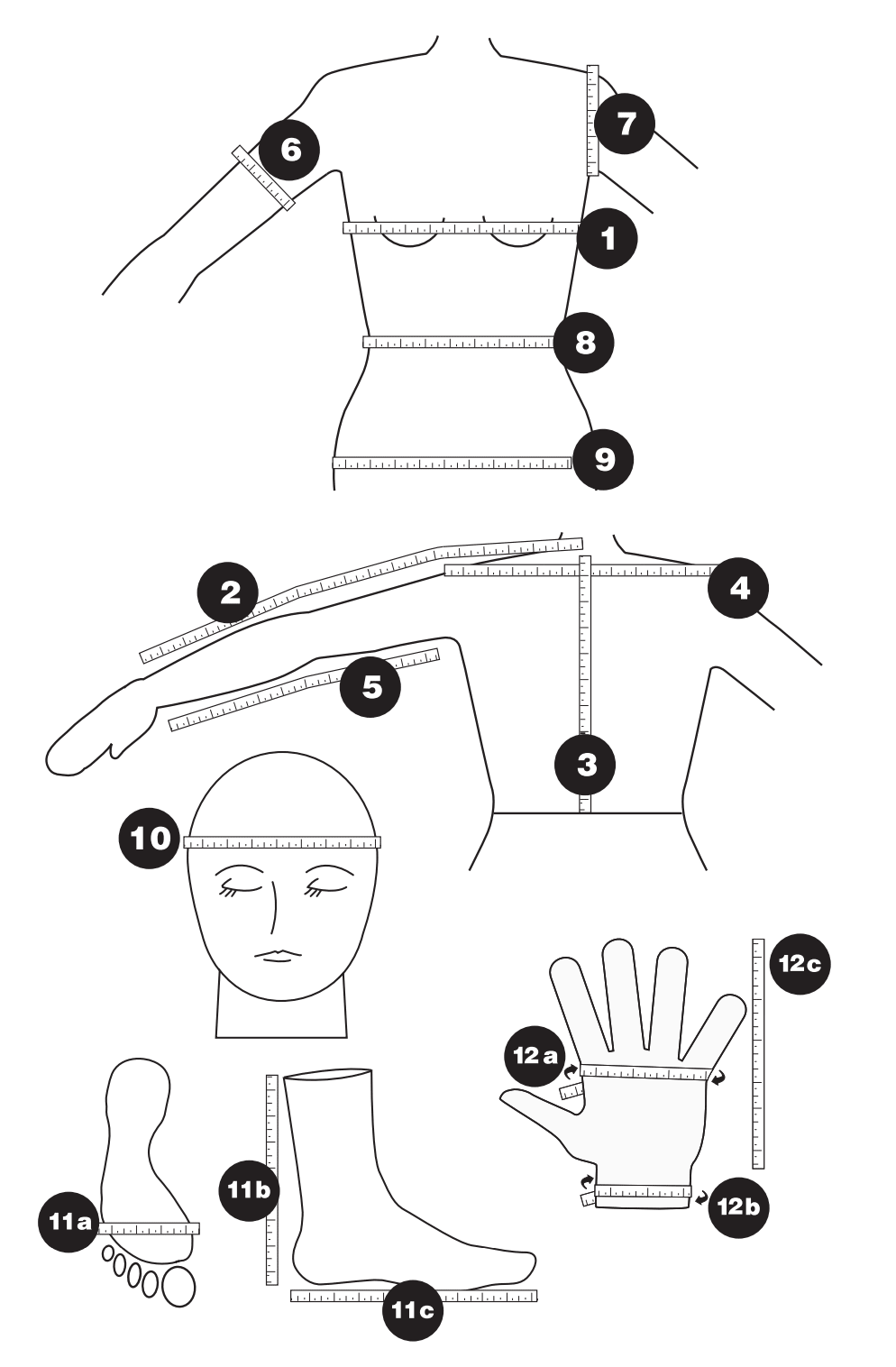To ensure that a finished garment will fit properly, it is important to take the following body measurements, so that you can determine what size you should make. It is always better to have someone else do the measuring. If that is not an option, you can measure a garment that fits you the way you want, and use these measurements as a guide. Most crochet and knitting pattern instructions will provide general sizing information, such as the chest or bust measurements of a completed garment. Many patterns also include detailed schematics or line drawings. These drawings show specific garment measurements(bust/chest, neckline, back, waist, sleeve length, etc.) in all the different pattern sizes. (See more about Schematics p. 25) To insure proper fit, always review all of the sizing information provided in a pattern before you begin.
Following are several sizing charts. These charts show Chest, Center Back Neck-to-Cuff, Back Waist Length, Cross Back, Sleeve Length, Upper Arm, Armhole Depth, Waist and Hip. THESE ARE ACTUAL BODY MEASUREMENTS FOR BABIES, CHILDREN, WOMEN, and MEN in both inches and centimeters.
When sizing sweaters, the fit is based on actual chest/bust measurements, plus ease (additional inches or centimeters), sometimes referred to as "negative ease" (less than the actual bust/chest measurement) or "positive ease" (more than the actual bust/chest measurement). The chart entitled “Bust/Chest Fit and Ease Chart” recommends the amount of ease to add or subtract to bust/chest measurements if you prefer a close-fitting garment, an oversized garment, or something in-between.
| Bust/Chest Fit and Ease Chart | |
|---|---|
| Very close fitting, negative ease: | Very tight fit, smaller than your actual bust/chest measurement. Approximately 2" to 4” (5 to 10cm) less than your actual bust/chest measurement |
| Close fitting, zero ease: | Body skimming, your actual bust/chest measurement. |
| Classic fit, some positive ease: | Comfortable fit slightly larger than actual bust/chest measurement. Approximately 2" to 4” (5 to 10cm) more than your actual bust/chest measurement |
| Loose fit, more positive ease: | Slightly oversized fit, larger than your actual bust/chest measurement. Approximately 4" to 6” (10 to 15cm) more than your actual bust/chest measurement |
| Oversized, generous positive ease: | Very loose fit, much larger than your actual bust/chest measurement. Approximately 6+” (15+cm) more than your actual bust/chest measurement |
| The Length Chart provides average lengths for children’s, women’s and men’s garments. | |
Both the FIT and LENGTH charts are simply guidelines. For individual body differences, changes can be made in body and sleeve lengths when appropriate. However, consideration must be given to the project pattern. Certain sizing changes may alter the appearance of a garment.
| Length Chart | Back Waist Length | Hip Length | Tunic Length |
|---|---|---|---|
| Child | Actual body measurement | 2"/5cm down from waist | 6"/15cm down from waist |
| Woman | Actual body measurement | 6"/15cm down from waist | 11"/28cm down from waist |
| Men | Men’s length usually varies only 1–2"/2.5–5cm from the actual “back hip length” measurement | ||
How to measure

1. Chest/Bust - Measure around the fullest part of the chest/bust. Do not draw the tape too tightly.
2. Center Back Neck–to-Wrist- With arm straight, measure from back base of neck, across shoulder, and along arm to wrist.
3. Back Waist Length- Measure from the most prominent bone at base of neck to the natural waistline.
4. Cross Back- Measure from shoulder to shoulder.
5. Arm Length- With arm slightly bent, measure from armpit to wrist.
6. Upper Arm- Measure around the widest section of the upper arm located above the elbow.
7. Armhole Depth- Measure from the top outside edge of the shoulder down to the armpit.
8. Waist- Measure your waist at the smaller circumference of your natural waist, usually just above the belly button.
9. Hip- Measure at the widest part of your lower hip.
10. Head Circumference- For an accurate head measure, place a tape measure across the forehead and measure around the full circumference of the head. Keep the tape snug for accurate results.
11. Sock Measurements- The following measurements are for crew-style or dress socks, which usually come several inches above the ankle and below the calf.
11a. Foot Circumference- To determine the foot circumference, measure around the widest part of your foot.
11b. Sock Height- To determine the height of the sock, measure from where you start to turn for the heel shaping to the top of the sock.
11c. Total Foot Length- To measure the total length of your foot, place a ruler or tape measure on the floor. Position the back of your heel at the beginning of the tape and the measure to your longest toe.
12a. Hand Circumference- Measure around the palm of your dominate hand, which is usually just below the knuckles. Exclude the thumb.
12b. Wrist Circumference- Measure around the widest part of the wrist.
12c. Hand Length- Measure from the wrist to the the base of the hand to the tip of the middle finger or to the top of the longest finger.
